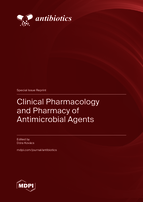Clinical Pharmacology and Pharmacy of Antimicrobial Agents
A special issue of Antibiotics (ISSN 2079-6382). This special issue belongs to the section "Pharmacokinetics and Pharmacodynamics of Drugs".
Deadline for manuscript submissions: closed (30 September 2023) | Viewed by 26022
Special Issue Editor
Interests: veterinary usage of antibiotics; antimicrobial resistance; antibiotic sensitivity testing; antibiotic alternatives
Special Issues, Collections and Topics in MDPI journals
Special Issue Information
Dear Colleagues,
One of the main health threats in human and veterinary medicine today is the development of antimicrobial resistance (AMR). This phenomenon develops as a result of overuse and misuse of antimicrobial agents and has led to several drugs becoming less effective and infectious diseases being difficult to treat. To successfully address the problem of AMR, it is of the highest importance to optimize the use of antimicrobials and to improve their efficacy. Combinational usage of different antimicrobials, antimicrobials with adjuvant agents, or repositioned drugs with antimicrobial efficacy are among the possible solutions.
In this Special Issue, we aim to collect studies on clinical pharmacology and pharmacy of antimicrobial agents from both human and veterinary medicine as the complex problem of AMR requires actions taken with the One Health approach, involving both fields. Studies about new or optimized usage of already authorized antimicrobials, as well as discoveries about new agents, combinations, and drug repositioning can be submitted. Pharmacodynamic, pharmacokinetic, and toxicological aspects of individual and combinational drug use can be covered. Comprehensive reviews of the field are also welcome.
Dr. Dóra Kovács
Guest Editor
Manuscript Submission Information
Manuscripts should be submitted online at www.mdpi.com by registering and logging in to this website. Once you are registered, click here to go to the submission form. Manuscripts can be submitted until the deadline. All submissions that pass pre-check are peer-reviewed. Accepted papers will be published continuously in the journal (as soon as accepted) and will be listed together on the special issue website. Research articles, review articles as well as short communications are invited. For planned papers, a title and short abstract (about 100 words) can be sent to the Editorial Office for announcement on this website.
Submitted manuscripts should not have been published previously, nor be under consideration for publication elsewhere (except conference proceedings papers). All manuscripts are thoroughly refereed through a single-blind peer-review process. A guide for authors and other relevant information for submission of manuscripts is available on the Instructions for Authors page. Antibiotics is an international peer-reviewed open access monthly journal published by MDPI.
Please visit the Instructions for Authors page before submitting a manuscript. The Article Processing Charge (APC) for publication in this open access journal is 2900 CHF (Swiss Francs). Submitted papers should be well formatted and use good English. Authors may use MDPI's English editing service prior to publication or during author revisions.
Keywords
- antibiotics
- antifungals
- antiviral agents
- antiparasitic agents
- pharmacology
- pharmacy
- pharmacodynamics
- pharmacokinetics
- toxicology
- interactions
- drug combinations
- repositioning
- synergism







